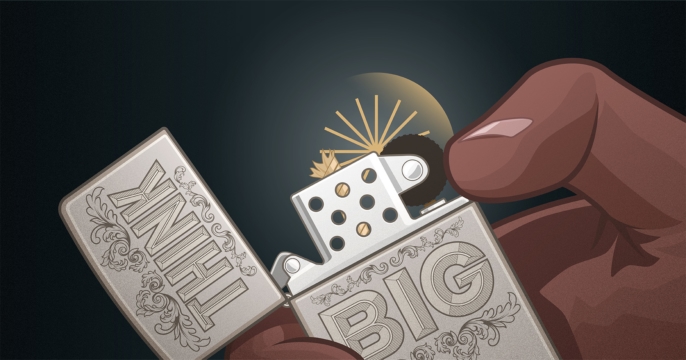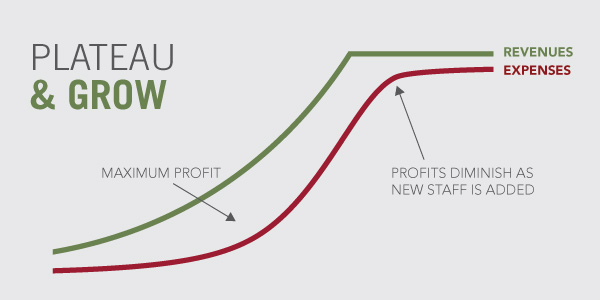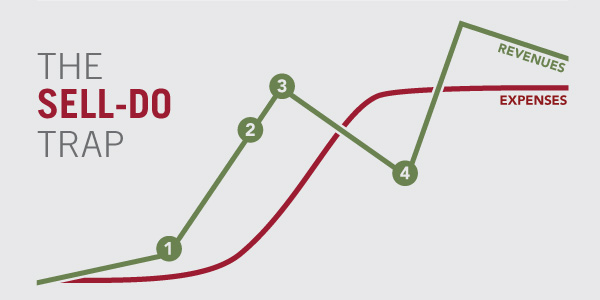
Introducing ‘The Spark’
‘The Spark’ is when business leaders stand right on the cusp of opportunity, but need a little extra oomph to move from inspiration to transformation. Keep an eye on the Kinesis blog for this new series.
If you run a professional services firm, or manufacture products to client specifications, I’m guessing you know what I mean when I say, “managing revenue is a challenge.”
Isn't “challenge” really just a nice way to say, “pain in the butt?”
The problem faced by most service providers is that their business models don’t scale well; adding more clients usually means adding more staff. And, as you know, adding more people means adding more direct expenses (salaries, benefits) as well as many indirect expenses (training, mistakes, cultural disruption).
As a result, many businesses experience a revenue/expenses graph that looks something like this:

We call this “Plateau and Grow,” meaning that the business sees a nice uptick in profits, followed by a flattening period as it incurs additional expenses.
While imperfect, Plateau and Grow is somewhat sustainable. It’s even viable if your company has solid recruiting systems, excellent customer service, and a strong culture of accountability. As you add new resources, the system is able to absorb disruptions (training, culture changes) and eventually moves from the flat profit area to a new, more profitable growth curve.

While the Plateau and Grow financial model is viable (assuming solid financial oversight), what really brings pause is when a business succumbs to Plateau and Grow’s distant cousin: "The Sell-Do Trap."
The Sell-Do Trap is so common among small-businesses that when I describe it, the near- universal response is acknowledgment and frustration. Here’s what the Sell-Do Trap Looks like from a top-line revenue perspective:

Stage 1: Sales-Fueled Growth. In the first phase, growth is fueled by a focused sales effort. For small businesses, this typically means the owner of the business is out hustling up new work and generating opportunities. It’s time consuming, but as the volume of work increases, things feel good. The owner’s employees are busy, contracts are signed, and the sales wins feel like “all is right in the world.”
Except that it’s not.
Stage 2: Too Busy. Right about the time the owner thinks she’s got it all figured out, signs of trouble begin to emerge. Expenses creep up. Travel costs grow. Employees lose efficiency and focus as 40 hours turn into 50 and 60. The owner spends more and more of her precious time managing projects and exhausted employees. Internal meetings are canceled in favor of delivering to the clients. Strategic planning goals begin to feel like an afterthought, and no one has time to market the business. In a word, it’s hectic.
Stage 3: Hiring. In an attempt to keep her head above water, the owner does what comes naturally when business and revenues grow: they hire. Adding new blood brings some relief to the beleaguered staff, but also creates challenges in getting the new hires up to speed. Internal priorities continue to be back-burnered, and the owner finds herself juggling team leadership, client happiness, and delivery of product. From a business-development standpoint, marketing and sales crawl to a halt.
Financially, things feel pretty good. The A/R cycle results in a sense of financial health as the checks start flowing in.
Unfortunately, this stage provides a false sense of security; experienced owners realize that there’s a cliff ahead. Costs climb significantly as the new employees become full-time; revenues are still on the rise, but the final project payout is just around the corner. Stage 4, The Crash, is close at hand.
Stage 4: the Crash. The final stage of the Sell-Do trap cycle occurs in that moment when expenses are at their highest, and new opportunities are at their lowest. Because the owner was so preoccupied in Stages 2 and 3, she hasn’t had time to generate the next cycle of revenue opportunities. Her profits come crashing back down to earth, and she experiences several months of slow or no-growth. Jumping back into “sales mode,” the owner pushes hard to create new work. Except it’s even harder this time around, as operating expenses are higher than ever before.
Several years ago, I coined the term “Sell-Do” as a quick way to describe businesses where the owners were responsible for delivering the work (they “sell” the work, then “do” the work). While this pitfall is particularly acute for owners who must be rainmakers, it's also a problem for businesses where client workload stalls critical initiatives like marketing.
To overcome the Sell-Do Trap, I’ve developed a few key strategies to help owners escape the frustration and financial pitfalls associated with Selling/Doing:
Many business owners are stuck in a never-ending Sell-Do trap cycle (I've been there!). While most service providers think this is simply a natural part of business, most are surprised that the path to freedom isn't nearly so far away. If you fit this profile and need help with your "great escape," drop me a line. I'm no Houdini, but I've been known to pick a lock or two.
Get insights like this straight to your inbox.